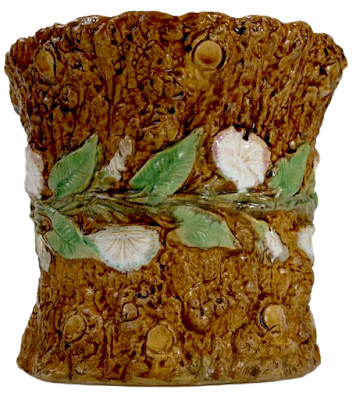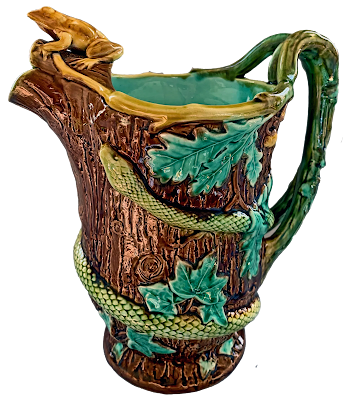The French term Faux Bois (literally translating into fake wood) has recently become a rather trendy way of describing anything that imitates an object with a wood-like appearance. Of course, artists for centuries have created objects that imitated the look of other objects. The artistic practice of trump l’œil is built around it.
The treatment of painting inexpensive woods to imitate more valuable ones is quite common among furniture makers. In fact the popular cabinet maker’s process of using veneer paper thin woods on top of inexpensive ones is a form of faux bois.
With the arrival of naturalism and the Aesthetic Movement in Victorian life, the creation of imitation wooden objects took on new momentum, with art imitating wood in all manner of media. Considering the nature of glazed pottery, ceramics, especially majolica, were particularly suited to this deception. Most majolica producing potteries created some faux boise ware, particularly for items created for conservatories. One majolica producing pottery in particular, George Skey’s Wilnecoate Works, made faux boise a cornerstone of their ceramic production. Their Rustic Ware line was defined by faux bois ceramics, usually supplemented by leaves and other natural items to give them added realism.
Of course other majolica producing potteries created such works as well, starting with the inventor of Victorian majolica, Minton.
George Jones did an unusual teapot and trivet as well as a couple of garden seats and a jardiniere in faux bois.
Other companies made garden seats with faux bois components.
Cane and umbrella stands are another field that sees quite a few faux bois pieces.
In addition to George Jones, other companies made faux bois tea items.
There are cheese domes and fern stands…
…and vases, jardinieres, pitchers, and other useful and decorative items.
Some of these items are incredibly convincing to the eye and only through touch can these be identified as ceramic. So, the bottom line is, mission accomplished!





















































No comments:
Post a Comment